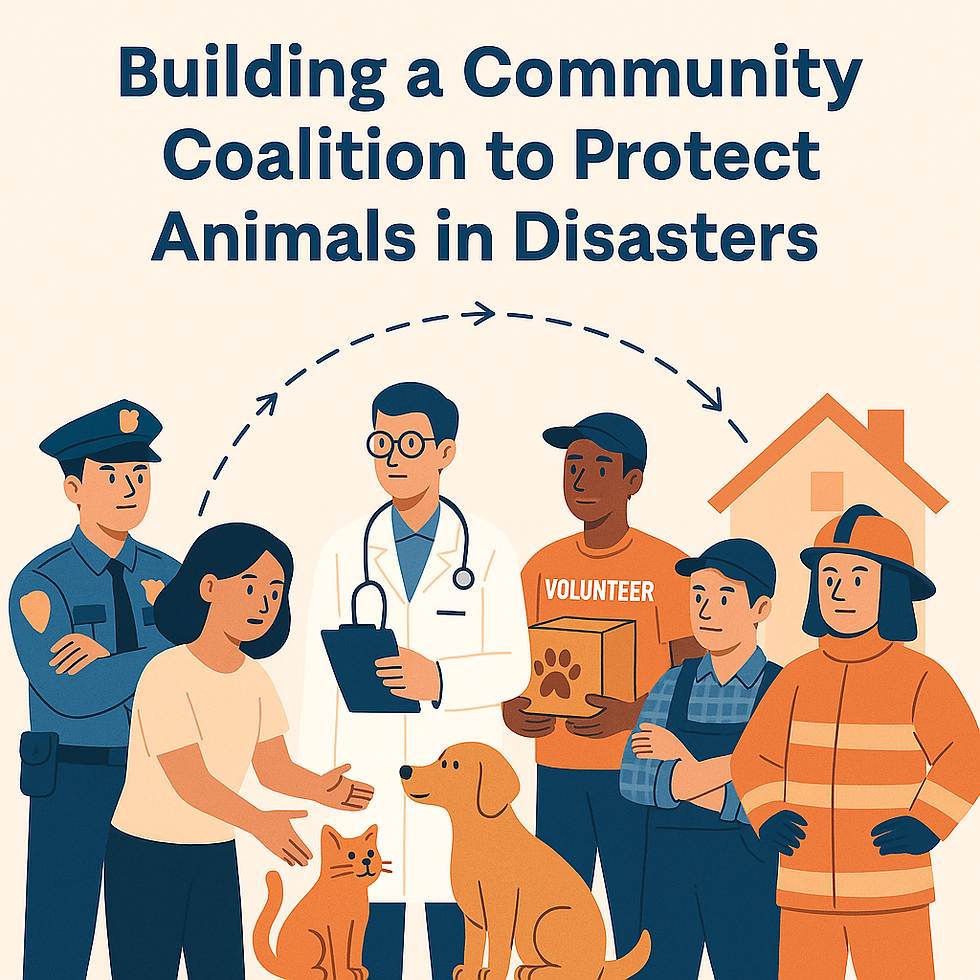Building a Community Coalition to Protect Animals in Disasters
- Kirk Carlson
- Jul 19
- 2 min read

By Covenant of Courage | Disaster Readiness Series
When disaster strikes—whether it’s a wildfire, flood, earthquake, or hurricane—the first priority is saving lives. But for millions of Americans, that includes the lives of their beloved pets, service animals, and livestock. Unfortunately, animal protection is often an afterthought in emergency planning. It doesn’t have to be.
A Unified Front: Why We Need Coalitions
Protecting animals during disasters is not the responsibility of a single agency or group—it’s a shared mission. Building a community coalition ensures that animal safety is woven into the fabric of emergency preparedness. A strong coalition brings together:
Local Emergency Managers – to incorporate animals into official emergency operations plans
Veterinarians and Animal Control Officers – to provide medical triage and animal handling expertise
Shelter Coordinators – to help ensure pets are not separated from their families during evacuations
Law Enforcement & Fire Services – to assist with animal rescues and safety enforcement
Faith-Based and Nonprofit Organizations – to help with public awareness, donations, and volunteer staffing
Agricultural Stakeholders & Livestock Owners – to plan large-scale evacuations and sheltering for farm animals
Citizens – because every prepared family strengthens the entire community
Steps to Build an Effective Animal Disaster Coalition
Start with a Meeting of Minds
Invite key players from local government, veterinary clinics, animal shelters, and emergency management to discuss current gaps in animal disaster response.
Assess Local Risks and Needs
Are you in a wildfire-prone region? Do you have a large farming community? Knowing your vulnerabilities helps prioritize resources.
Create a Shared Response Plan
Develop protocols for evacuation, sheltering, feeding, veterinary care, identification, and reunification of animals.
Train Together
Host drills and simulations involving animal evacuation and sheltering. FEMA’s Independent Study courses and state emergency management training programs can be valuable resources.
Engage the Public
Launch a pet preparedness campaign. Encourage pet microchipping, emergency go-bags for animals, and family evacuation planning.
Leverage Funding and Grants
Seek funding through local, state, and federal programs—such as those offered by FEMA, AVMA, and humane societies—to support training, equipment, and shelters.
Keep It Going
Form a formal task force or advisory committee that meets regularly, updates plans, and coordinates seasonal messaging (e.g., hurricane prep, wildfire safety).
Why It Matters
History shows us that when animals are excluded from emergency plans, people suffer. Some refuse to evacuate without their pets. Others attempt rescues in dangerous conditions. A strong animal response strategy doesn’t just save four-legged lives—it saves human lives, too.
Conclusion
By building a coalition, your community is better equipped to handle the unexpected. It’s a humane, smart, and lifesaving investment in your region’s resilience.
📬 Contact: support@reasonableranks.org
🖊 Sign the petition: https://chng.it/5yXYvkBtMR
🌐 Learn more: www.covenantofcourage.com





Comments